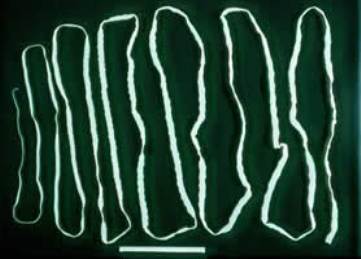Adaptation
A change for the better!
The tapeworm is a master at adapting to its surroundings. Its flat body is ideal for absorbing maximum amount of nutrients because of it surface area to volume ratio. A scolex was formed so the adult could say attached to its host, especially when its prime living space is in the intestine. Remember the intestine works at removing waste from the body so a strong attachment point is necessary for staying in the gastrointestinal tract. The tapeworm also took advantage of the intestine to help it continue its life cycle and reproduce, so it developed the segmented proglottids that would break off and be passed through the feces. The feces of it definitive host would be released into the external environment and the cow would then eat the grass that was contaminated with the eggs allowing the larvae to have an intermediate host to reside.
Now, the relationship between cattle and humans are only recent, because
domesticating these animals and farming is a fairly new occurrence when looking
at the process of evolutionary adaptation.
It is said that
Taenia
tapeworm’s origin actually began in
Now take a closer look at the Life Cycle of Taenia saginata.
